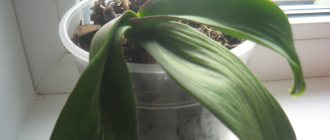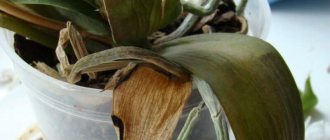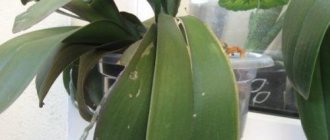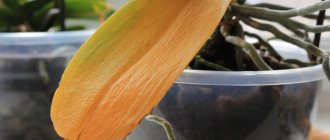Care errors
When the color of orchid leaves changes, first of all, check compliance with the rules of care. Thus, under the influence of direct sunlight, burns appear, which are characterized by reddening of the leaves. This happens because the leaf produces a protective red pigment to protect against burns.
For reference! If sunburn occurs, yellow spots may appear on the leaves.
The orchid is shaded from direct sunlight by blinds and a sheet of paper. The sun is especially dangerous in the spring, when the orchid is no longer artificially illuminated, but is exposed to the sun. During such a transition period, the window should be shaded, for example, with tulle. The orchid is fed to strengthen the immune system. Lack of phosphorus is also one of the possible reasons for leaves turning red.
For reference! The orchid is moved to another place if the change in color is followed by tissue death. This signals a burn. However, if the leaves do not curl, do not lose turgor, and the plant blooms, then this is a natural color.
Before the actual burn appears, the leaves range in color from dark red to inky black. It is most often found on Cattleyas, which are prone to red pigmentation of the leaves. There are varieties that do not bloom without first darkening the leaves. In this case, a change in color indicates sufficient lighting.
When there is insufficient light, the leaves stretch out and turn light green. The orchid is weakening. This state of the plant is ideal for the appearance of pests and diseases.
What is contraindicated to do?
- If infected with a disease, it is not allowed to leave the flower near other plants.
- Do not open the tubercles and growths on the leaves of phalaenopsis.
- Failure to comply with basic temperature and watering rules is unacceptable. An indifferent attitude leads to the death of the flower.
Phalaenopsis leaves, surrounded by attention and care, are less susceptible to diseases and pests. Now you know in what conditions an orchid feels comfortable in order to grow and delight you with its blooms.
Diseases
One of the symptoms of fungal diseases may be the leaves becoming reddish-brown. The difference from an ultraviolet burn is the presence of small specks, which over time combine to form large spots.
Anthracnose is a disease caused by a fungus. It appears with high air humidity and accumulation of liquid in the axils of the leaves. Inspect the lower part of the leaf and shoots for spots. They will have a dry core, often cracked with holes, and a clearly visible border around the edges. The color of the border will be dark pink and lilac. The disease sometimes affects pseudobulbs. Over time, the spots increase in size, become depressed, and a yellowish or pinkish coating appears.
Brown rot is characterized by dark brown spots, but depending on the original color of the leaves, the spots may have a red tint. The affected areas soften and die. If the lesions are minor, the orchid can be helped. Otherwise, you just have to throw away the plant.
How can you tell if the leaves are having problems?
Orchid is susceptible to bacterial, fungal and viral diseases . Leaves damaged by a viral infection are cut off to save the flower. If the orchid is completely affected, treatment is not possible. Phalaenopsis leaves affected by bacteria become covered with plaque, rot, become overgrown with cones (growths), become flabby and, in some cases, become covered with red dots.
External manifestations of phalaenopsis leaf disease:
- the main leaf mass fades;
- leaf blades wrinkle and turn yellow;
- leaves dry out along the entire length of the stem;
- the plant in the container is no longer stable.
The appearance of pests must be eliminated in the early stages without aggravating their development.
Pests
to a lack of nutrients by turning red leaves. However, the reason may be hidden in the presence of pests, which, by damaging the roots, trunk and leaves, prevent nutrients from reaching the plant cells from the substrate.
The presence of spider mites is manifested by a silvery coating on the back of the leaf blade. The color gradually changes to red-brown. Spider mites enter the room and settle on orchids from an open window, and are introduced into potted indoor roses. The pest loves dry, warm air.
An atypical but possible symptom of scale insects is small red dotted spots that change color to brown or black.
Are there orchids with naturally red leaves?
In nature, there are types of orchids that have variegated leaf plates.
- Ludisia – its leaves have a silky feel to the touch dark crimson shade. The flowers of this species do not represent anything original. East and Central Asia is considered the homeland;
- Phalaenopsis Schiller – has colored leaves with a red pattern. The Philippines is considered the homeland of this species.
Plants with colored leaves are quite decorative, but their flowers often have an unpresentable appearance.
What to do if the leaves turn red
There are varieties of orchids with red shades of leaves: Ludisia, Phalaenopsis Schiller. In this case, the red color is natural and nothing needs to be done.
To avoid burns, the lighting should be diffused; if possible, the pot should be placed on a west-facing window. Some types of orchids are placed in direct sun in the morning and evening hours, when the sun's rays are not aggressive.
If the redness of the leaves is caused by pests or diseases, chemicals are used. The treatment is carried out on the balcony or on the street, using personal protective equipment: a mask and gloves. After the procedure, wash your face and hands thoroughly.
Treatment of diseases
If there are suspicions of diseases and/or pests, the orchid is isolated from other indoor flowers. The plant is carefully removed from the pot, the roots are immersed in lukewarm water. Using tweezers or your hands, remove pieces of bark and other components of the substrate from the roots. Next, the rotten parts of the orchid are cut off with sterile instruments, the sections are sprinkled with cinnamon, activated charcoal or charcoal.
Note! Do not use alcohol-containing preparations to treat cuts: you will burn the roots.
Next, drugs are used. Use against rot and anthracnose
- " Quadris ". The product, penetrating the plant, fights infection. It begins to act an hour after spraying the orchid. The drug in an amount of 1 ml is diluted in 2 liters of water.
Advice! If the plant was not isolated in time and there is a fear of infecting other pets, all flowers are treated.
- " Acrobat " is a preventive and therapeutic remedy for fungal diseases. 4 grams of the drug are diluted in 1 liter of water. Apply no more than 3 times with an interval of 10-14 days.
- " Pure color " is a concentrated emulsion. Take 1 ml of the drug for 2-2.5 liters of water. The orchid is sprayed.
- " Aktellik " fights pests, including ticks. The leaves are sprayed with a solution of 1 ml of the product in 1 liter of water.
- "Apollo" . An effective means of combating mites and laid eggs. Practically non-toxic. Treatment is carried out with a solution of 1 ml of product per 1 liter of water.
- " Aktara " helps in the fight against scale insects. Highly toxic. 1 ml of the drug is diluted in 1 liter of water.
- “ BI-58 ” is a combined drug for scale insects. Take 1 ml of product per 1 liter of water.
Important! When treating anthracnose, treatment with a systemic fungicide is mandatory. This guarantees the neutralization of fungi deep in the tissues.
After all the procedures, the plant is transplanted into a new pot and the soil is changed. The container for the orchid is transparent, with smooth walls. Be sure to have drainage holes. In almost all varieties of orchids, the roots participate in photosynthesis, so access to light is necessary. The volume of the pot is selected according to the size of the root system. The plant is not allowed much freedom; the flower loves cramped spaces. A special soil is used for orchids. Collect them yourself or purchase them in a store. After recovery, watering is reduced and the orchid is not fed.
Getting rid of pests
Acaricides or insectoacaricides are used against spider mites. The orchid is transferred to the street or balcony and sprayed with a solution. Gloves and a mask are used, people and pets are removed from the premises. Place a plastic bag over the plant and leave it for several days. During the day, the homemade greenhouse is ventilated for 10-15 minutes. Treatment is carried out at intervals of 3-5 days, at least 3 times.
Note! Spider mites are dangerous because they feed on plant sap and cause bacterial, fungal and viral infections.
Scale insects and false scale insects parasitize on the branches or trunks of plants and live on the back side of the leaf. It feeds on orchid sap, secreting a sticky substance on which a sooty fungus is formed. The fungus spreads throughout the plant, clogging the pores, thereby preventing the orchid from breathing. The plant withers and its condition worsens.
A sign of the appearance of scale insects are sticky spots on the leaves. Females lay well-protected eggs. Young individuals spread throughout the orchid, feed on plant juices and look for a place of attachment. As a result, the orchid turns yellow and the leaves fall off.
If a plant is damaged, before treating it with chemicals, it is cleaned of scale insects and false scale insects. Use tweezers, a cotton swab, and a toothpick. Examine the axils of the leaves, their reverse side, stem and buds. Carefully, using tools, remove individuals.
Note! Be sure to sterilize instruments before use. Thus, in case of accidental damage to the plant, infection will not occur.
When all individuals have been removed, the soil is watered with a systemic insecticide of contact-intestinal action. The orchid sap becomes poisonous, and the scale insect that feeds on it dies.
Advice! The pot and window sill where the orchid stands are also treated.
The treatment is repeated twice with an interval of 15 days. When all the individuals have died, you can clean the plant from the “cocoons” with a toothbrush.
What to do in case of reddening leaves?
When the leaf mass of an orchid turns red, you first need to find the reason for this and only then take action to eliminate the red tint.
Lighting normalization
If it's all about lighting , you need to move the container with the plant deeper into the room. The window should be covered with blinds or white cloth.
This will create a lot of diffused light , which is necessary for good cultivation of the plant.
But we must remember that the plant cannot exist in continuous shade. Therefore, when moving it away from the window, you need to take care that the orchid still receives the required number of rays. Otherwise, flowering and normal leaf development will stop.
Treatment for infections
If a red coating or tint appears due to harmful insects , care must be taken to ensure that the plant does not infect the rest of the collection, and therefore it is quarantined away from the rest.
After which they carefully examine it, maybe even with a magnifying glass . And as soon as the pest is identified, it is eliminated using the appropriate chemical.
After which the plant is left in quarantine for another 2 weeks to make sure that it is healthy and the pests have left it.
Prevention
The first rule that will prevent problems with orchids and other indoor plants: a newly purchased flower is quarantined . For a period of 1 month, the pot with the plant is isolated from other flowers. For the first 2 days, the orchid is placed in a cool, dark place. This prevents excessive stress. Upon completion of quarantine, the plant is transplanted into fresh substrate. The pot is left the same (if it meets the above characteristics), but sterilized before filling with new soil.
Note! When transporting an orchid in cold and/or windy weather, the plant must be carefully packed in cellophane or paper, which is not removed for 1-2 hours after delivery to its destination. This is done to reduce stress and the risk of hypothermia.
Preventive measures consist of creating favorable conditions for the growth and development of the orchid in accordance with its variety. The location chosen is western. If it is not possible to place a flower on the west window, then:
- On the north side, the orchid needs artificial lighting. Daylight hours for all varieties must be at least 10 hours.
- On the south window, the flower must be shaded.
To strengthen the immune system, plants are treated with purchased drugs and homemade products. Among homemade solutions, garlic water and succinic acid have good reviews. To prepare the solution, take 1 clove of garlic, chop it, add 1 liter of cold water and leave for 24 hours in a warm place. To enhance the effect, add 1 tablet of succinic acid to the solution, which is pre-dissolved in hot water. Mineral fertilizers are also applied.
Note! A healthy plant does not need fertilizing. Fertilize a weakened orchid that has suffered from illness. The plant is fed during the period of active vegetative growth, in the first week after flowering. Before feeding, water the flower so as not to burn the roots.
To prevent brown rot and anthracosis, biological fungicides are used: Mikosan, Fitosporin, Alirin and Gamair, Trichodermin. In addition, it is recommended to treat the flower with copper sulfate once a month. Avoid mechanical damage to roots, leaves, buds, into which infection and fungus can penetrate. If the substrate was collected in nature, it is calcined before use. Often bark and moss brought from the street contain fungi and insects.
To avoid rot and anthracnose, water the orchid only when the soil is completely dry. To check the condition of the substrate, use a wooden stick. It is placed at a depth of 2-3 cm. Then they take it out and see whether it is dry or wet. Water when the stick is dry.
Important! Self-collected soil components are sterilized at elevated temperatures, since anthracnose can withstand negative temperatures.
When watering orchids, avoid getting water on flowers and buds. The axils of the leaves are blotted with a dry cloth, the pot is left in the bathroom to drain off excess liquid.
To prevent the appearance of spider mites, the air must be periodically humidified. Humidifiers are used, and a container of water or wet expanded clay is placed next to the orchid. The plant is watered with a warm shower and sprayed regularly. Orchids love fresh air, but mites do not. Therefore, it is important to carry out regular ventilation, while protecting the orchid from drafts.
Important! If the substrate elements were collected in nature, they are sterilized at high temperatures. An oven is used for this purpose. The bark can be boiled, left until completely dry, and soaked for 2 days before use.
To prevent the appearance of pests and diseases, the plant is periodically inspected. Pay attention to the roots (it’s good if the pot is transparent and the root system is visible). Examine the leaf axils and their reverse side. If there are even minor deviations, action should be taken. Often the plant cannot be saved because the disease has developed too much.
Reasons for changes in leaf color
Lighting
When orchid leaves take on an uncharacteristic color, they are signaling that they are feeling uncomfortable. This means that it is necessary to establish a “diagnosis” and eliminate the cause.
If the orchid leaves turn red, it means the plant feels uncomfortable.
Often the owner of orchids, having learned that this is a light-loving plant, puts it on the brightest windowsill - in the south. After some time, when exposed to direct sunlight, the leaves change color. The size of the spots and shades of red from pink to purple depend on the angle at which the beam fell. This occurs from excess ultraviolet radiation, which is harmful to orchids; phalaenopsis are especially affected.
Solving this problem is not difficult, you just need to move the orchid to another place. The north-west window sill is preferable:
- In the morning, when the sun rises, the direct rays do not cause harm, because they are not yet burning.
- In the afternoon, the plant is protected from the scorching sun because it is in partial shade.
If it is not possible to move the phalaenopsis, then it needs to be provided with diffused lighting . To do this, you can stretch a mesh fabric, such as tulle, over the window or hang a lattice blind.
Diffused light for an orchid can be created using lattice blinds.
In cases where the orchid is exposed to the scorching sun for at least a couple of hours every day, its leaves will dry out and curl.
Spots on the leaves of phalaenopsis orchids: white, black, yellow
Like any living creature, plants also get sick. In orchids, the leaves are the first to suffer. Let's take a closer look at why this happens and what to do about it.
What factors can contribute to the pathological process?
First of all, improper care:
- exposure to direct sunlight on foliage. Carefully choose the location of the flower;
- excessive humidity. Make sure that the soil does not stagnate with water;
- insufficient ventilation. Check to see if the container with the plant has enough holes. Or they are too small. Ideally, the diameter is at least 1 centimeter. Make sure that they are located evenly around the entire perimeter of the dish and on its bottom;
- air stagnation. Well ventilate the room where the orchid is located. However, avoid drafts. Some varieties are afraid of them;
- poorly chosen pot. It should be the right size: neither too tight nor too big. Still, the plant needs to be replanted periodically. Each time, buy dishes exactly according to the volume of the root system;
- improper watering. Some species cannot be watered from above. This is due to the structural features of the leaf. As a result, moisture accumulates at its base, provoking the process of rotting;
- poor quality substrate. Optimally, it is loose, without lumps, all components are distributed evenly. Water drains well from it. After watering, the soil does not pile up. He smells nice. Has sufficient drainage;
- unbalanced fertilizer. It is not only the correct ratio of components that is important. Consider the required time for feeding, quantity, frequency. All this depends on the type of orchid and its characteristics. Its exact name will help you here.
Pathogens
One or more of the above reasons can lead to the following problems:
- fungal infection. It affects the leaves and stem of the plant. The probable cause is high humidity plus low temperature;
- bacteria. They develop deep in the tissues of the flower. More often this happens when some part of the orchid is injured. Stagnation of moisture also causes rotting;
- viral diseases. The reason is physiological characteristics.
Phalaenopsis diseases
Let's look at some of the problems that cause spots on orchid leaves.
Hives
Dark brown defects appear immediately after infection. They are round in shape, up to 3 mm in diameter. Next comes the spread throughout the flower. The reason is low temperature, excessive humidity, and insufficient ventilation.
Bacillus Cypriped
A dangerous, common disease of orchids. Caused by the pathogenic bacillus Cypriped. The development of bacteria is promoted by high temperature and humidity. A small, light, rapidly growing spot appears. Then the affected parts soften, darken, smell bad, and shrink. Reason: improper watering or spraying.
Dry spots
The leaf becomes covered with a brown spot, which gradually spreads throughout the phalaenopsis. This fungal infection occurs due to high humidity.
Late blight
A serious disease caused by the fungus Phytophtora cactorum. Purple blemishes appear on the leaves, which then darken to black. The plant may die. Reason: excessive density of the substrate, abundant watering.
Mesophyll collapse
Yellow spots of uneven shape are observed. Then they seem to press in the affected part. To prevent this from happening, avoid cold water for watering and spraying.
Bacterial spot
It is caused by the fungus Cercospora. The outer side of the leaf is covered with yellow uneven spots of 5-10 mm. Internal - moldy. This is caused by high temperature and poor ventilation.
Phyllostictina Pyriformis
Fungal infection. Manifested by the presence of yellow or black spots. They may remain unchanged for several months. This is the period when deep within the tissues there is a rapid process of development of the mycelium. Ends with the death of the leaf plate.
Chlorosis
Exposure to chlorine causes black blemishes on leaves. After they curl, the plant dies.
Burkholderia gladioli
A bacterial disease in which dark spots are identified, mistaken for frostbite.
What to do if your pet is injured? Necessary activities:
For bacterial infections, cut off the affected areas with a sterile instrument. The cut areas are disinfected with brilliant green, charcoal, and fungicide.
The plant is provided with a moderately warm, not sunny place with good ventilation. They are allowed to rest for several days, without watering.
Unfortunately, there are problems in which the orchid dies. For example, chlorosis, late blight. Therefore, it is important to take preventive measures in time.
What ailments can affect the leaves and what do they look like in the photo?
Most often, the leaves of the phalaenopsis orchid are affected by non-infectious diseases that arise due to improper care.
Only after a thorough examination of the flower can you understand the cause of the pathological process:
- Yellow foliage below - lack of moisture or errors during maintenance in winter.
- Yellow spotting or white spots are rot, pests or powdery mildew.
- Droopy foliage – aphids, mites, bacterial spot.
- Sticky Spot – Aphids, Bacterial Spot and Powdery Mildew.
- Black spot - rot, spider mites or improper watering in autumn and winter.
- Soft and wrinkled leaves are pests, bacterial spot and fusarium rot.
- Leaf rotting is fusarium rot that occurs due to improper watering.
- Red leaves are pests, rotting due to improper moisture in the cold season.
- Curling - pests and rot.
- The edges turn black – bacterial spotting.
- Mold is a pest.
- Silvery plaque – gray rot, powdery mildew and pests.
- White bugs are pests that occur against the background of frequent watering or high humidity.
You can learn more about what diseases and pests can destroy phalaenopsis and how to save the plant in this article.
Next in the photo you can see what the leaf plates of an orchid look like with various diseases or pest damage.











